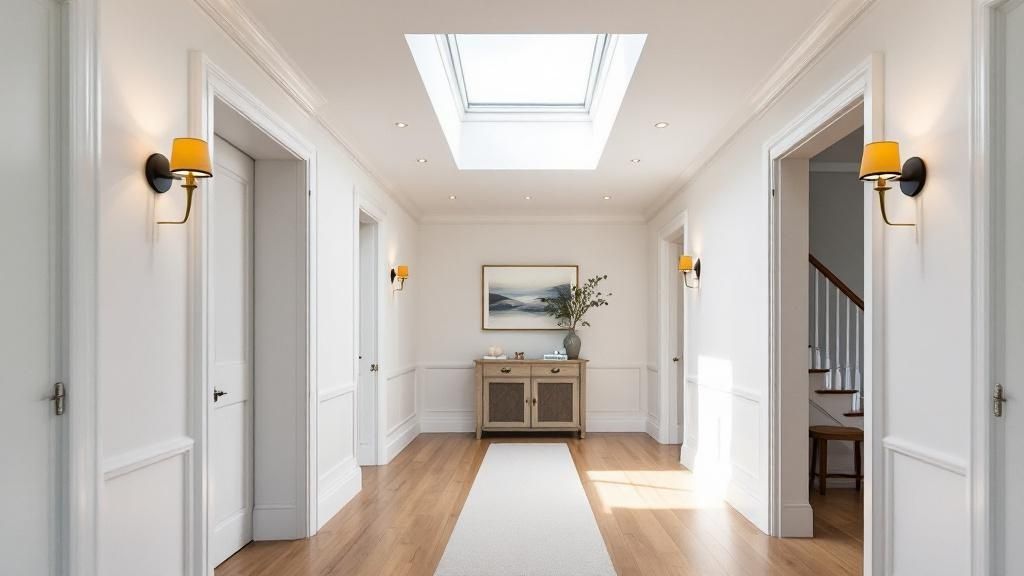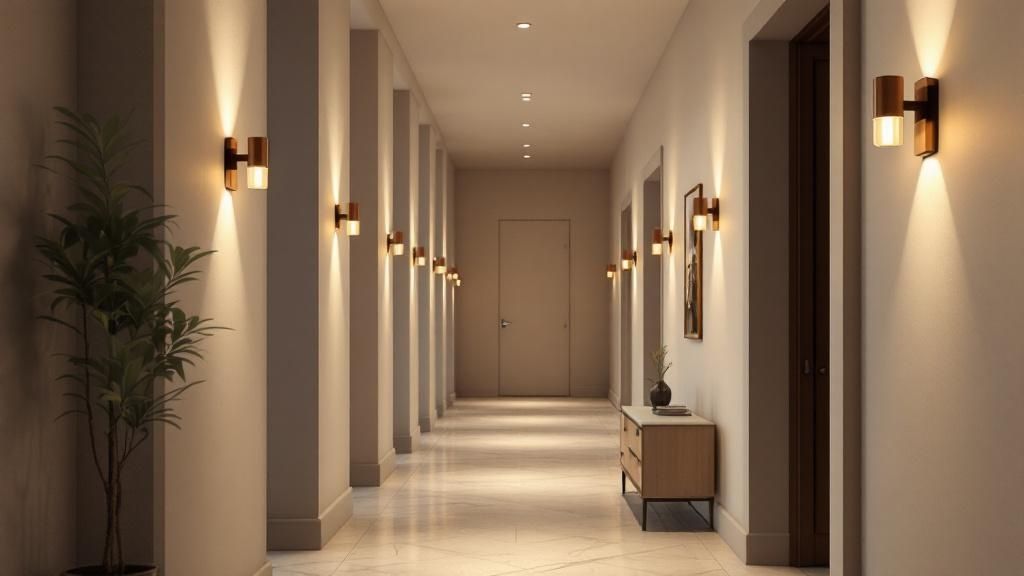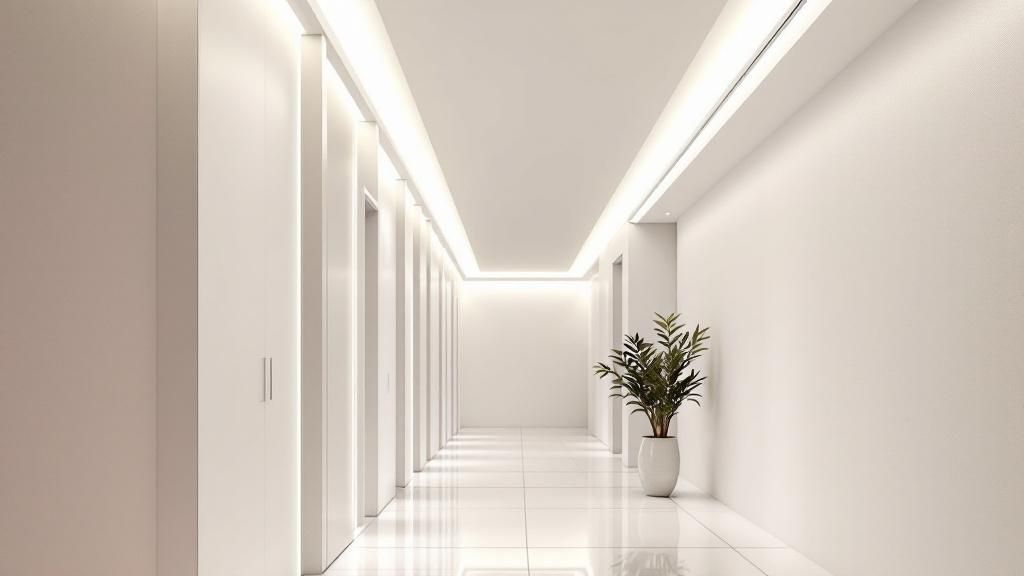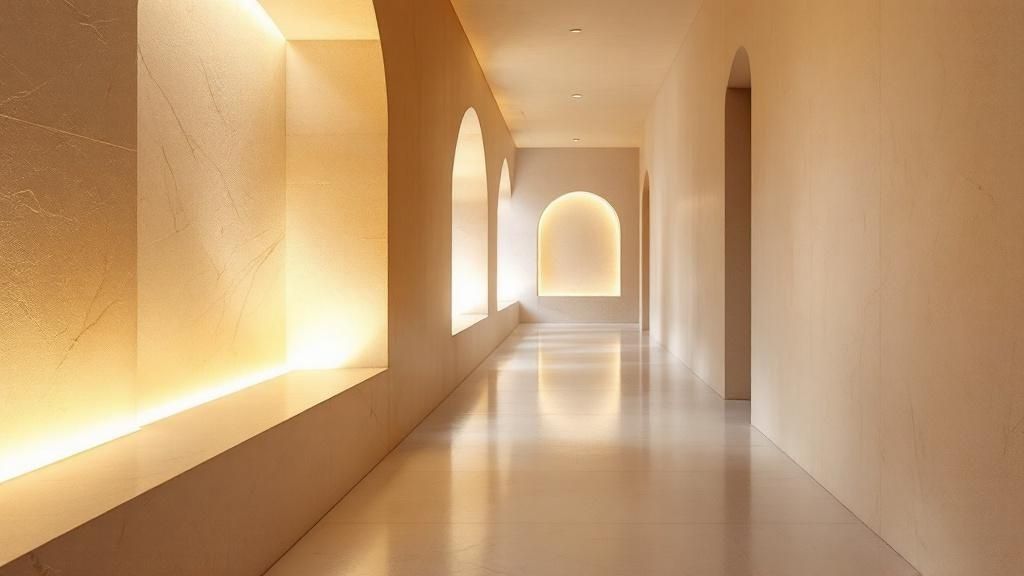 Hallways are the arteries of our homes, yet their lighting is often an afterthought. A well-lit hallway not only ensures safe navigation but also sets the architectural tone and enhances the perceived value of your property. For homeowners in Canterbury, where a blend of heritage architecture and modern design prevails, selecting the right illumination is key to creating a welcoming and cohesive interior. This guide explores a range of practical and stylish hallway lighting ideas, moving beyond basic fixtures to reveal how strategic lighting can transform these transitional spaces from mere corridors into impressive design features.
Hallways are the arteries of our homes, yet their lighting is often an afterthought. A well-lit hallway not only ensures safe navigation but also sets the architectural tone and enhances the perceived value of your property. For homeowners in Canterbury, where a blend of heritage architecture and modern design prevails, selecting the right illumination is key to creating a welcoming and cohesive interior. This guide explores a range of practical and stylish hallway lighting ideas, moving beyond basic fixtures to reveal how strategic lighting can transform these transitional spaces from mere corridors into impressive design features.We will delve into solutions that cater to various ceiling heights, architectural styles, and functional needs. From the sleek integration of recessed LEDs to the artistic statement of pendant lights, you’ll find the perfect way to brighten every step of your home’s journey. Beyond the aesthetics, a crucial aspect of any lighting installation involves selecting the right electrical fittings and materials to ensure safety and longevity. This comprehensive list provides actionable insights for every type of hallway, helping you make informed decisions that align with both your design vision and practical requirements.
1. Natural Light Transformation with Skylights
Among the most transformative hallway lighting ideas, none rival the power of natural daylight. Installing a skylight or roof window can fundamentally alter a dark, enclosed corridor, turning it into a bright and inviting passageway. This solution is particularly effective for central hallways, a common feature in many Canterbury homes, which often suffer from a lack of direct window access and can feel gloomy.
Harnessing sunlight not only creates a more pleasant atmosphere but also reduces your reliance on artificial lighting throughout the day, contributing to energy savings. Modern architectural design increasingly embraces this approach, connecting a home’s interior with the natural rhythms of the day and promoting a healthier living environment.
Implementation and Best Practices
To make the most of a skylight installation, consider these practical tips:
- Placement is Key: Position the skylight centrally in a long hallway. This ensures the most even and balanced distribution of light, preventing harsh bright spots and deep shadows.
- Enhance Diffusion: Construct a splayed light well (where the opening at the ceiling is wider than the skylight itself). This technique spreads the incoming sunlight over a much larger area.
- Add Ventilation: Stuffy upper-floor corridors benefit immensely from an electric opening model. Brands like Vivid Skylights offer options that double as a source of fresh air.
- Control the Light: For complete command over brightness, especially in areas where light might be disruptive, opt for a model with integrated block-out blinds.
2. Wall Sconces
Wall sconces are one of the most classic and versatile hallway lighting ideas, offering a perfect blend of ambient and accent light. Mounted directly onto the wall, they provide illumination without occupying valuable floor or ceiling space, making them ideal for narrow or long corridors. From the grand hallways of historic Canterbury homes to sleek, modern apartments, sconces add a layer of sophistication and create a warm, welcoming atmosphere through layered lighting.

This approach is highly effective for breaking up the monotony of a long hallway, adding visual interest and rhythm to the space. The fixtures themselves act as decorative elements, contributing to your home’s overall design aesthetic, whether you prefer traditional lantern styles or minimalist geometric shapes. Integrating sconces is a key technique in architectural lighting design, helping to guide the eye and define the space. For more on this, you can explore detailed principles of architectural lighting design.
Implementation and Best Practices
To integrate wall sconces effectively, follow these professional guidelines:
- Optimal Height: Mount fixtures so the centre of the light source is approximately 150-170 cm (60-66 inches) from the finished floor. This places them at eye level, preventing direct glare.
- Correct Spacing: For a balanced look, space sconces between 1.8 to 3 metres (6-10 feet) apart in a long hallway. This ensures even light distribution without creating cluttered visuals.
- Create Symmetry: Always use matching pairs of sconces to create a sense of balance and formal elegance. Place them opposite each other or in a repeating pattern down one side.
- Reduce Glare: Choose fixtures with frosted glass shades or those that direct light upwards or downwards. This diffuses the light, creating a softer, more ambient glow that is comfortable on the eyes.
3. Linear LED Strip Lighting
For a sleek, architectural look, linear LED strip lighting is one of the most versatile and modern hallway lighting ideas available. This approach involves installing continuous LED strips within recessed channels, along ceiling coves, or integrated into features like stair risers or handrails. It provides a seamless, uniform line of light that minimises shadows and creates a high-end, sophisticated ambiance, perfect for contemporary homes across Canterbury seeking a clean aesthetic.

The beauty of LED strips lies in their flexibility and low profile, allowing them to be hidden from direct view. This creates an indirect glow that can wash walls with light, define architectural lines, or provide subtle safety lighting along floors. Popularised by leading brands like Philips Hue and Lutron, this solution is as much a design element as it is a functional light source, offering excellent energy efficiency and longevity.
Implementation and Best Practices
To achieve a professional and polished finish with LED strips, consider these key tips:
- Ensure Proper Heat Management: Always install LED strips inside an aluminium channel. This acts as a heat sink, preventing the LEDs from overheating and significantly extending their lifespan.
- Avoid the “Dotted” Look: Use a frosted or opal diffuser cover with your channel. This component blends the individual light points into a single, continuous line of light, eliminating harsh hot spots.
- Integrate Dimming Controls: A dimmer is essential for adjusting the atmosphere. A bright, functional light can be softened to a subtle, ambient glow for evenings, making the space far more versatile.
- Explore Smart Controls: For ultimate convenience, connect your strips to a smart system. This allows you to schedule lighting, change colours (with RGBW strips), and control everything from your phone.
4. Pendant Lighting
Pendant lights offer a powerful combination of functional illumination and decorative flair, making them one of the most versatile hallway lighting ideas. These fixtures, suspended from the ceiling, act as striking focal points, drawing the eye upwards and adding a touch of elegance or drama. They are particularly effective in hallways with higher ceilings, a common feature in many heritage homes across Canterbury, where they can fill vertical space without obstructing the walkway below.

From minimalist geometric designs in modern lofts to rustic lantern styles in traditional homes, pendants can define or enhance your home’s aesthetic. By choosing the right style, you can transform a simple corridor from a purely functional area into a curated design statement, setting the tone for the rest of your home.
Implementation and Best Practices
To integrate pendant lighting effectively into your hallway, consider these key tips:
- Maintain Clearance: Ensure the bottom of the fixture hangs at least 2.1 to 2.4 metres (7-8 feet) from the floor. This provides ample headroom and keeps the walkway clear and safe.
- Group for Impact: In longer hallways, installing a series of pendants creates a visually appealing rhythm. Using an odd number, such as three or five, often results in a more balanced and aesthetically pleasing arrangement.
- Consider Scale and Spacing: Choose a pendant size that is proportional to your hallway’s width and height. Space multiple lights evenly to provide consistent illumination and avoid creating dark patches between them.
- Adjust Cord Length: Carefully plan the cord or chain length before installation to achieve the desired height. An electrician can help ensure the fixtures are hung securely and at a uniform level for a polished look.
5. Track Lighting Systems
For ultimate flexibility and directional control, track lighting systems offer one of the most versatile hallway lighting ideas. This solution involves multiple individual light fixtures, known as heads, mounted on a continuous track. It allows you to precisely aim light exactly where it’s needed, making it perfect for highlighting artwork, family photos, or unique architectural details along a corridor.
Track lighting is particularly effective in long hallways where the function of the space might evolve. Homeowners in Canterbury who enjoy rotating art displays or redecorating will find this system adapts effortlessly to new layouts without requiring complex electrical work. The ability to add, remove, or reposition light heads provides a level of customisation that fixed fixtures cannot match, ensuring your hallway is always perfectly illuminated.
Implementation and Best Practices
To install a track lighting system effectively, consider these professional tips:
- Plan for Art Placement: Before installation, determine the average height and position of artwork or features you want to highlight. This ensures your track is placed optimally to achieve the best lighting angles.
- Vary Your Beam Angles: Use a mix of light heads with different beam angles. A narrow beam (spotlight) is ideal for accenting a single small object, while a wider beam (floodlight) can wash a larger wall section or provide general ambient light.
- Blend with the Ceiling: For a more minimalist and subtle look, choose a track that can be painted to match your ceiling colour. This helps the system blend in, allowing the light and the highlighted objects to be the main focus.
- Choose Low-Voltage Options: Modern low-voltage track systems, often using LEDs, are highly energy-efficient and offer a sleek, contemporary aesthetic. Brands like WAC Lighting and Juno Lighting provide a wide range of stylish and efficient options.
6. Flush Mount Ceiling Fixtures
For hallways with lower ceilings or where maintaining maximum headroom is a priority, flush mount fixtures offer an ideal solution. These lights attach directly to the ceiling surface, providing ample ambient illumination without protruding into the space. This makes them a go-to choice for many modern and older homes across Canterbury, especially in apartment buildings or basements where ceiling height is often standard or restricted.
The versatility of flush mount fixtures is a key reason for their enduring popularity. Available in countless designs, from minimalist utilitarian circles to ornate, decorative pieces, they can seamlessly integrate into any decor scheme. This adaptability ensures they remain one of the most practical and stylish hallway lighting ideas available, providing broad, even light distribution that makes any corridor feel more open and navigable.
Implementation and Best Practices
To select and install the perfect flush mount fixtures, keep these tips in mind:
- Choose Diffused Shades: Opt for fixtures with frosted glass or fabric shades. This helps to diffuse the light evenly, preventing harsh glare and creating a softer, more welcoming ambiance.
- Size Appropriately: The fixture’s diameter should be proportionate to the hallway’s width. A small light can look lost in a wide corridor, while an oversized one can feel imposing.
- Consider LED Options: Integrated LED flush mounts are an excellent investment. Brands like Kichler and Quoizel offer models that are highly energy-efficient and boast an incredibly long lifespan, minimising maintenance.
- Match Your Decor: Select a style that complements your home’s existing aesthetic. Whether you need a simple, modern design for a utility corridor or a period-appropriate fixture for a traditional home, there is a flush mount to suit.
7. Motion-Sensor Lighting
For the ultimate blend of convenience, safety, and energy efficiency, motion-sensor lighting is an intelligent solution for any hallway. This technology automatically illuminates a corridor when movement is detected and switches off after a set period of inactivity. It’s a fantastic addition to any home, especially in Canterbury households where navigating a dark hallway at night can be a common occurrence. This hands-free operation ensures you are never fumbling for a switch with your hands full.
This automated approach is one of the most practical hallway lighting ideas for reducing energy consumption, as lights are only active when truly needed. By preventing lights from being left on by mistake in low-traffic areas like basements, utility corridors, or long passageways, motion-sensor systems contribute directly to lower power bills and a more sustainable home.
Implementation and Best Practices
To integrate motion-sensor lighting effectively, consider these key tips:
- Set an Appropriate Timer: The ideal duration depends on the hallway’s length. Set the timer long enough to walk the entire length comfortably without the lights switching off prematurely.
- Adjust Sensitivity: To prevent false triggers from pets or ambient movement like curtains, adjust the sensor’s sensitivity settings. This ensures the lights only activate for human traffic.
- Strategic Sensor Placement: Position sensors at the entry points of the hallway for immediate activation. For long corridors, installing multiple sensors ensures continuous coverage.
- Explore Dual-Technology: For high-traffic or complex areas, consider dual-technology sensors (combining passive infrared and ultrasonic) for superior accuracy and reliability. Models from brands like Lutron and Leviton offer excellent options.
8. Cove and Indirect Lighting
For a truly sophisticated and seamless aesthetic, cove and indirect lighting stands out among hallway lighting ideas. This high-end technique involves placing light sources within ledges, recesses, or behind architectural mouldings. The light is directed upwards or sideways, washing across ceilings and walls to produce a soft, diffuse glow that eliminates harsh shadows and creates a luxurious, hotel-like ambiance.
The result is an elevated experience where the source of light is hidden, making the hallway feel effortlessly bright and spacious. This method is exceptionally effective in long corridors or entryways where you want to make a strong design statement, turning a purely functional space into a feature of your home’s architecture. It is a fantastic strategy when considering how to brighten a dark room without visible fixtures.
Implementation and Best Practices
To successfully integrate cove lighting, careful planning is paramount:
- Plan During Construction: This technique is best incorporated during a new build or major renovation, as it requires creating structural recesses or ledges. Retrofitting can be complex and costly.
- Choose Warm Colour Temperatures: For a welcoming and comfortable atmosphere, use LED strips with a warm colour temperature (2700K-3000K). This creates a cosy, inviting feel.
- Ensure Easy Maintenance: Design the cove with easy access in mind. You will eventually need to clean the channel or replace the LED strips, so ensure it is not permanently sealed.
- Incorporate Dimming Controls: Installing a dimmer switch gives you complete control over the mood, allowing you to transition from bright, functional light to a soft, ambient glow for the evening.
9. Picture and Accent Lighting
Transform your hallway from a simple thoroughfare into a curated gallery with picture and accent lighting. This sophisticated approach uses small, focused fixtures to illuminate specific features like artwork, photographs, or unique architectural details. It’s an excellent way to inject personality and create visual interest, turning a functional space into a personalised journey through your home.
By creating layers of light, this method adds depth and character, making the corridor feel more deliberate and inviting. Whether you’re showcasing a family photo wall or a prized piece of art, accent lighting draws the eye, tells a story, and provides a soft, ambient glow that enhances the entire area. This is one of the most effective hallway lighting ideas for adding a touch of elegance and individual style.
Implementation and Best Practices
To properly highlight your decor and architectural elements, consider these tips:
- Protect Your Artwork: For valuable paintings or photographs, use fixtures with UV-filtering lenses to prevent colours from fading over time. This is a crucial, often overlooked detail.
- Achieve the Perfect Angle: Position your light source so it strikes the artwork at a 30-degree angle. This minimises glare and prevents distracting shadows from being cast by the frame.
- Select the Right Beam Spread: Match the width of the light beam to the size of the object you’re illuminating. A narrow beam is ideal for a small sculpture, while a wider floodlight works better for a large canvas.
- Consider Heat Output: Traditional halogen bulbs can generate significant heat, potentially damaging delicate artwork over long periods. Modern LED options from brands like WAC Lighting are a cooler, more energy-efficient alternative.
10. Smart Lighting Systems
For the ultimate in convenience, customisation, and efficiency, smart lighting systems represent the cutting edge of hallway lighting ideas. These systems utilise connected LED bulbs, switches, and sensors that are controlled via smartphone apps, voice assistants like Alexa or Google Assistant, or automated schedules. This level of control transforms a simple corridor into a responsive and intelligent part of your home, perfectly adapting to your family’s daily rhythms.
This technology is especially beneficial for busy households, allowing you to dim lights for a relaxed evening atmosphere or ensure they are never left on by mistake. In modern Canterbury homes aiming for complete automation, smart systems like Philips Hue or Lutron Caseta integrate seamlessly, offering both sophisticated ambiance and significant energy savings. Explore more smart tips for saving electricity at home to maximise your home’s efficiency.
Implementation and Best Practices
To integrate smart lighting into your hallway effectively, follow these best practices:
- Start Small, Expand Later: Begin by upgrading a few key fixtures, such as the main overhead light or a feature lamp. You can gradually expand the system to other areas as you get comfortable with the technology.
- Ensure Strong Wi-Fi: Smart lighting relies on a stable wireless connection. Before investing, check that your hallway has strong and consistent Wi-Fi coverage to prevent frustrating dropouts.
- Automate Your Routines: Set up schedules that align with your daily life. For instance, program the lights to turn on at a low brightness in the morning and automatically switch off when everyone has left for the day.
- Use Geofencing for Hands-Free Control: Many systems offer geofencing, which uses your phone’s location to automatically turn the hallway lights on as you arrive home, providing a safe and welcoming entrance.
Hallway Lighting Ideas Comparison Chart
| Lighting Type | Implementation Complexity 🔄 | Resource Requirements ⚡ | Expected Outcomes 📊 | Ideal Use Cases 💡 | Key Advantages ⭐ |
|---|---|---|---|---|---|
| Recessed LED Ceiling Lights | Medium – requires ceiling work | Moderate – LED fixtures, wiring | Clean, modern, energy-efficient, even light | Narrow hallways, modern apartments, offices | Space-saving, low maintenance, energy efficient |
| Wall Sconces | Low to Medium – wall wiring needed | Low – wall mounts and bulbs | Warm ambiance, decorative interest | Traditional and modern hallways, artwork lighting | Adds architectural interest, versatile styles |
| Linear LED Strip Lighting | Medium to High – professional recommended | Moderate to High – LED strips, diffusers | Dramatic, seamless illumination, color options | Luxury hotels, modern offices, residential coves | Highly customizable, energy efficient, mood lighting |
| Pendant Lighting | Low to Medium – simple ceiling installation | Low to Moderate – fixture purchase | Visual focal points, ambient and task lighting | High ceilings, decorative hallways | Visual appeal, variety of designs, easy installation |
| Track Lighting Systems | Medium – ceiling track installation | Moderate – multiple fixtures | Flexible, adjustable lighting, highlight features | Art galleries, retail, flexible lighting zones | Adjustable, cost-effective, multi-head flexibility |
| Flush Mount Ceiling Fixtures | Low – surface mount installation | Low – simple fixtures | General ambient lighting, maximum clearance | Low ceiling hallways, basements | Affordable, easy installation, preserves headroom |
| Motion-Sensor Lighting | Medium – sensor wiring | Moderate – sensors and fixtures | Hands-free, energy-saving, safety-enhancing | Utility areas, high traffic hallways | Energy efficient, enhances safety, automatic |
| Cove and Indirect Lighting | High – architectural modification | High – recessed fixtures, design | Soft, luxurious ambiance, shadow-free light | High-end hotels, luxury homes, corporate spaces | Luxurious feel, glare reduction, space-expanding |
| Picture and Accent Lighting | Medium – precise positioning, electrical work | Moderate – focused fixtures | Highlights artwork, adds personality | Galleries, residential art collections | Enhances artwork, professional look, focused beam |
| Smart Lighting Systems | Medium to High – networked controls | Moderate to High – smart bulbs and hubs | Customizable, automated, energy optimized | Tech homes, rentals, elderly care | Convenience, energy saving, remote control |
Choosing the Right Light for Your Canterbury Corridor
Navigating the multitude of hallway lighting ideas can feel as complex as designing the rest of your home, but the journey from a dim, uninspired passage to a brilliantly lit corridor is a rewarding one. As we have explored, the right lighting strategy does more than simply illuminate a path; it sets the mood, enhances architectural features, and creates a seamless flow throughout your Canterbury property. The key takeaway is that a one-size-fits-all approach rarely succeeds. Your home’s character, from a modern build to a classic period house, deserves a tailored lighting solution.
We’ve covered a comprehensive range of options, from the sleek, minimalist appeal of recessed LEDs and linear strip lighting to the statement-making elegance of a well-chosen pendant or the practical flexibility of a track lighting system. Wall sconces offer ambient warmth, while flush mounts provide a practical solution for low ceilings. Each of these artificial lighting methods serves a unique purpose and can be combined to create a sophisticated, layered effect that addresses ambient, task, and accent lighting needs simultaneously.
Synthesising Your Hallway Lighting Strategy
The most impactful designs often arise from a thoughtful synthesis of these ideas. Consider how different fixtures work in tandem. For instance, recessed downlights can provide excellent general illumination, but combining them with wall sconces adds depth and softens shadows, creating a more welcoming atmosphere. Similarly, integrating smart lighting systems offers unparalleled control over this layered scheme, allowing you to adjust brightness and colour temperature to suit any occasion, from a brightly lit morning rush to a subdued evening glow.
Ultimately, the goal is to transform your hallway from a mere transitional space into an integral part of your home’s design narrative. This involves a careful assessment of your specific needs:
- Functionality: Do you need bright, clear light for safety on stairs or is the primary goal to create a soft, inviting ambiance? Motion-sensor lights offer an excellent blend of convenience and energy efficiency, activating only when needed.
- Aesthetics: Does your lighting need to be a bold decorative statement, like a sculptural pendant, or should it be a subtle, integrated feature, such as hidden cove lighting?
- Proportion: The scale of your fixtures must complement the dimensions of your hallway. A grand chandelier in a narrow corridor can feel overwhelming, while a single, small flush mount in a long, high-ceilinged hall will feel inadequate.
By carefully considering these elements and revisiting the diverse hallway lighting ideas presented, you can craft a solution that is not only visually stunning but also profoundly practical. Your corridors will no longer be overlooked but will become beautifully curated galleries that guide you and your guests through a home that feels cohesive, considered, and brilliantly illuminated.
Ready to introduce the ultimate source of illumination to your home’s darkest corridors? While artificial fixtures are essential, nothing compares to the quality of natural daylight. Explore how Vivid Skylights can transform your Canterbury hallway into a bright, welcoming space, reducing your reliance on electricity and enhancing your home’s atmosphere. Visit Vivid Skylights to discover the perfect skylight solution for your project.
